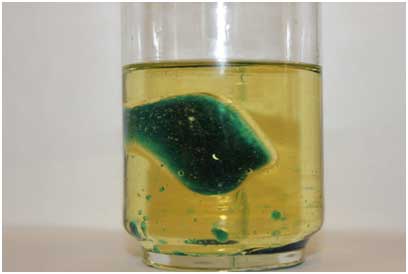Physics in a Glass: Ice and Oil

Some say water and oil don't mix, but what about ice and oil?
What you Need
- An ice cube tray
- Food coloring
- A clear glass
- Vegetable oil
What to Do
- Add a drop of food coloring to one of the molds in an ice cube tray.
- Add water to the ice cube tray.
- Place ice cube tray in the freezer until frozen.
- Fill a clear glass halfway full with oil.
- Remove the colored ice cube from the ice cube tray.
- Put the colored ice cube in the glass of oil and watch it melt.
- What happened?
What's Going On?
Both oil and ice can be slippery, but this is where the similarity ends. Oil and ice have very little in common. Actually, oil doesn't like ice, or more specifically melted ice, water. Oil is known as hydrophobic, meaning that it repels water. When you put the ice cube in the oil it begins to melt. It doesn't mix with the oil because oil is hydrophobic. This explains why the oil and water don't blend together, but this doesn't explain why the water goes to the bottom of the cup and why the ice floats at the top of the cup. This is all comes back to density, or how much stuff is in an object. If something is denser than something else, it will sink. Water is denser than oil; that's why water sinks to the bottom of the glass. Ice, however, is a funny solid. When water freezes and turns to ice, it actually takes up more space than it did when it was water, but it has the same amount of stuff in it. This means it is less dense than water. That's why ice cubes float in your water glass. Since ice is less dense than water, the water settles to the bottom. Since the ice is less dense than water and therefore less dense than oil, it floats at the top.
Try This!
- Try placing a colored ice cube in a glass of water. What happens as the ice melts?
- Try refreezing your first experiment with the oil and water. What happens to the water at the bottom? What happens as the experiment starts to defrost? Why do you think this happens?
More Information
http://nicholasacademy.com/scienceexperiment250wateroilice.html











